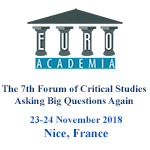Euroacademia Conferences
 Europe Inside-Out: Europe and Europeanness Exposed to Plural Observers (9th Edition) April 24 - 25, 2020
Europe Inside-Out: Europe and Europeanness Exposed to Plural Observers (9th Edition) April 24 - 25, 2020 Identities and Identifications: Politicized Uses of Collective Identities (9th Edition) June 12 - 13, 2020
Identities and Identifications: Politicized Uses of Collective Identities (9th Edition) June 12 - 13, 2020 8th Forum of Critical Studies: Asking Big Questions Again January 24 - 25, 2020
8th Forum of Critical Studies: Asking Big Questions Again January 24 - 25, 2020 Re-Inventing Eastern Europe (7th Edition) December 13 - 14, 2019
Re-Inventing Eastern Europe (7th Edition) December 13 - 14, 2019 The European Union and the Politicization of Europe (8th Edition) October 25 - 26, 2019
The European Union and the Politicization of Europe (8th Edition) October 25 - 26, 2019 Identities and Identifications: Politicized Uses of Collective Identities (8th Edition) June 28 - 29, 2019
Identities and Identifications: Politicized Uses of Collective Identities (8th Edition) June 28 - 29, 2019 The European Union and the Politicization of Europe (7th Edition) January 25 - 26, 2019
The European Union and the Politicization of Europe (7th Edition) January 25 - 26, 2019 7th Forum of Critical Studies: Asking Big Questions Again November 23 - 24, 2018
7th Forum of Critical Studies: Asking Big Questions Again November 23 - 24, 2018 Europe Inside-Out: Europe and Europeanness Exposed to Plural Observers (8th Edition) September 28 - 30, 2018
Europe Inside-Out: Europe and Europeanness Exposed to Plural Observers (8th Edition) September 28 - 30, 2018 Identities and Identifications: Politicized Uses of Collective Identities (7th Edition) June 14 - 15, 2018
Identities and Identifications: Politicized Uses of Collective Identities (7th Edition) June 14 - 15, 2018
Scientific Visualisations of Urban Heritage as Identity Making Image Construction
-
-

-
Presentation speakers
- Dominik Lengyel, Faculty of Architecture, BTU University of Technology Cottbus-Senftenberg, Germany
- Catherine Toulouse, Faculty of Architecture, BTU University of Technology Cottbus-Senftenberg, Germany
Abstract:
Identity relies to a large amount on history. So tangible and intangible cultural heritage provides a base of collective memory. The shape of urban space is something that requires a spatial experience whilst any way of depicting urban space demands a selective view. The history of photography is too young to include most of the history of urban change. An urban image construction can therefore not operate in a holistic way that connects today’s cities with its own history. Purely historic representations therefore act as distant sites of memorialisations. Anchoring a city’s history to today’s everyday life demands a consistent way of communication a city’s structure and continuity. Not as a theatrical scenery but as an intellectual structure with its own identity and meaning. In the context of scientifically visualizing hypotheses of archaeology and art history we have developed a method for visualizing urban transformations that focus on structural features enabling to get historic shapes with a minimum of fictional content. It consists of two complementary parts: virtual modeling and virtual photography. Contrasting the geometric abstraction of the model, strictly based on the verbal hypotheses, our way of depicting the scenery uses traditional methods of realistic architectural photography. Leaving out any staffage, the emphasis lies on the architectonic identity of cityscapes as symbolic order, demanding reflections by their spectators. The presentation aims to demonstrate and illustrate this method by several projects developed by the authors in cooperation with archaeological research institutions like Cologne Cathedral and its Predecessors (by order of and exhibited in Cologne Cathedral), The Metropolis of Pergamon (within the German Research Fund Excellence Cluster TOPOI, actually exhibited in Leipzig as part of Sharing Heritage, the European Cultural Heritage Year 2018), The Palatine Palaces (by order of the German Archaeological Institute, both latter exhibited in the Pergamon Museum Berlin).
-
Related Presentations

Performing Lecture: Practice as Research (PaR)
- Jane Arnfield













